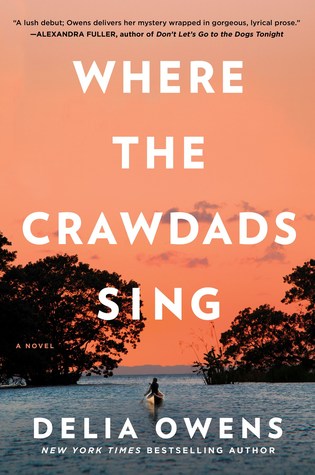|
“The morning burned so August-hot, the marsh’s moist breath hung the oaks and pines with fog.” ~ Where the Crawdads Sing by Delia Owens
Wildlife Scientist Delia Owens grew up as an adventurous outdoorsy child in 1950s rural Georgia, where she learned to contentedly play and explore nature on her own. Now a bestselling Nature Writer, Owens understands solitude, having spent decades conducting research in remote areas of the United States and studying elephants and lions in Africa. When this Winner of the John Burroughs Award for Nature Writing sat down ten years ago to write Where the Crawdads Sing, her intent was to create a novel that “explore[d] how isolation affects a person.” Her story is about Kya Clark, a child also growing up in the fifties, coming of age in the mysterious marshland of North Carolina’s Outer Banks. Owens gets the setting right. Her description of rural southeastern coast and its natural inhabitants instantly took me back to marsh country. I could smell the sweetgrass and see the fireflies. And like Owens, some of Kya’s best friends are part of nature. Yet unlike Owens who pursued a solitary lifestyle, young Kya falls victim to an unlikely series of events that instead force her to fend for herself. Kya’s mother flees an abusive alcoholic husband. Then one by one, Kya’s older siblings depart, until she is finally and completely abandoned by her father. By age ten Kya must learn to survive and so becomes the wild “Marsh Girl,” not fit for school nor society, rather “bonded to her planet and its life in a way few people are.” Kya relies on the marsh; “whenever she stumbled, it was the land who caught her…the marsh became her mother.” Befriended by a shrimper’s son, Tate Walker, who teaches her to read, Kya is ultimately encouraged to cultivate her gift for archiving marsh specimens. Tate also leaves. And though Kya is skilled in solitude, she yearns to be close to someone and begins a secretive relationship with a self-serving Romeo, Chase Andrews. When in 1969, this former lover (and attacker) is discovered dead, Kya is suspected. Small town drama ensues, and Kya endures a long theatrical trial, her cherished freedom hanging in the balance. The plot alternates between the trial and earlier time frames. Owens described the writing process as “like a giant 150,000-word puzzle.” As a reader, I sensed it wasn’t effortless. She portrays her timeline afterthoughts as an editing “nightmare.” For this reader, the shifts seemed counterintuitive and curbed any suspense I may have felt for the fate of the main character. And Kya’s plaintive tale is all too much pathos, lacking the compelling and authentic complexity of real human experience. I wished to connect, but Kya felt so contrived a vehicle, designed to teach the reader how solitude shapes and distorts. Owens’s nature writing depicts the natural world in such vivid accurate detail. Fiction arguably requires as much truth from so skillful a writer. ~Ann Scott Originally published November 29, 2018 in the Aspen Daily News
0 Comments
Your comment will be posted after it is approved.
Leave a Reply. |
Adult News & reviewsLibrary news, info about upcoming events, reviews of books and films, and a look at the topics that affect us as a library. Archives
July 2023
|
General |
Borrowing |
About |


 RSS Feed
RSS Feed
